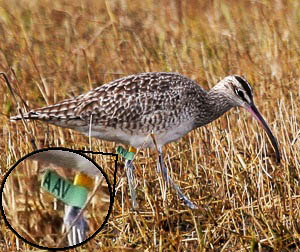Evidence for whimbrel population decline continues to mount
United States Nightjar Survey wraps-up third year
September 10, 2009Azalea back to Potomac River
September 12, 2009
Written by Bryan Watts
September 11, 2009

Whimbrel with coded flag foraging on the seaside – The whimbrel is one of may birds marked on the Delmarva that is beginning to reveal clues about stopover duration and migration pathways.
Inset: magnified view of whimbrel’s leg tag.
Photo by Alex Wilke.
Surveys within major migratory staging areas may provide one of the best assessments of shorebird population sizes and trends particularly for species that are widely dispersed during both the breeding and winter periods. Since 1994, Bryan Watts of The Center for Conservation Biology (CCB) and Barry Truitt of The Nature Conservancy (TNC) have been conducting aerial surveys of shorebirds staging along the seaside of the lower Delmarva Peninsula in Spring. In addition to the outer barrier beaches, these surveys have included a network of 10 transects across the lagoon system between the islands and the mainland. This habitat is the primary staging area for several species including dunlin, short-billed dowitchers, ruddy turnstones, marbled godwits, black-bellied plovers, and whimbrel.

Network of aerial transects located within the barrier island-lagoon system of the lower Delmarva. Photo by the Center for Conservation Biology.
The number of whimbrels staging along the lower Delmarva Peninsula have declined significantly since the mid-1990s. In just 12 years, the peak number of birds detected within the network of transects declined by 50%. [Figure 1] This equates to a 3-4% annual rate of decline for peak and accumulated numbers. The underlying causes of this decline remain unclear. CCB and TNC are continuing to work intensively to delineate migration pathways for this species and to learn more about stopover and winter ecology link to previous stories.

Fig. 1 – Seasonal pattern of whimbrel counts within aerial transects. Peak numbers have declined by 50% over the 12-year period. Photo by the Center for Conservation Biology.
The seaside lagoon complex of the lower Delmarva Peninsula has been designated as a hemispheric shorebird reserve, recognizing its importance to migrant shorebirds. The site represents a critical, coastal staging area for Whimbrel, where birds congregate to feed on the staggering numbers of fiddler crabs that inhabit the lagoon system and build up energy reserves before making their last overland flight to the breeding grounds. The importance of the lower Delmarva as a refueling site was demonstrated this past spring when a bird fitted with a satellite transmitter left the shore and flew more than 5,000 kilometers (3,200 miles) to the MacKenzie River in 146 hours.

This mudflat habitat is across the channel from the community of Willis Wharf. Mudflat patches are common along the Delmarva seaside and are critical to several shorebirds such as whimbrel that stage within this site before flying to breeding grounds in the arctic. Photo by Bryan Watts.
Project sponsored by The Center for Conservation Biology (CCB), The Nature Conservancy (TNC), and the Virginia Department of Game & Inland Fisheries (VDGIF).



